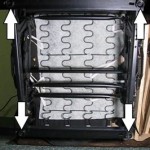How to Wash Feather Sofa Pillows: A Comprehensive Guide
Feather sofa pillows offer a comfortable and luxurious touch to living spaces. However, these pillows require regular cleaning to maintain their loft, hygiene, and overall appeal. Dust, dirt, body oils, and allergens accumulate within the feathers and fabric over time, necessitating a proper washing routine. Understanding the correct methods for washing feather pillows is crucial to avoid damage and ensure they remain fluffy and supportive for years to come. Improper washing can lead to clumping, mildew growth, and even irreversible damage to the feathers themselves.
This article provides a comprehensive guide on how to wash feather sofa pillows effectively and safely. It covers essential preparation steps, washing techniques (both machine and hand washing), proper drying methods, and tips for maintaining the quality of feather pillows.
Key Point 1: Pre-Wash Preparation and Assessment
Before washing any feather sofa pillow, a thorough inspection and preparation process is essential. This helps to identify potential issues, select the appropriate cleaning method, and minimize the risk of damage during the washing process. The initial assessment should focus on the following aspects:
Fabric Condition: Carefully examine the pillow's fabric cover for any tears, loose seams, or weak spots. Washing a pillow with a damaged cover can exacerbate the problem, leading to feather leakage and further damage. If the cover is torn, it should be repaired before washing. If the fabric is significantly degraded, consider replacing the cover entirely or having it professionally repaired.
Stain Removal: Pre-treat any visible stains on the pillow cover before washing. Use a mild stain remover specifically designed for delicate fabrics. Avoid harsh chemicals or bleach, as these can damage the feathers or cause discoloration of the fabric. Test the stain remover on an inconspicuous area of the pillow first to ensure it doesn't cause any adverse reactions.
Allergy Considerations: For individuals with allergies, consider using a hypoallergenic detergent specifically formulated for sensitive skin. This helps to remove allergens like dust mites and pet dander that may be trapped within the feathers. Double-check the detergent label to confirm it is suitable for use on delicate fabrics.
Machine Suitability: Evaluate whether the pillow is suitable for machine washing. Larger or heavily stuffed pillows may be too bulky for smaller washing machines. In such cases, hand washing or professional cleaning may be a better option. Consult the pillow's care label for specific washing instructions from the manufacturer. If no instructions are available, proceed with caution and consider hand washing as a safer alternative.
Dusting and Vacuuming: Before washing, remove loose dust and debris from the pillow by gently shaking it outdoors or using a vacuum cleaner with an upholstery attachment. This helps to prevent the dust from becoming embedded in the feathers during the washing process.
Key Point 2: Washing Techniques – Machine Washing vs. Hand Washing
Choosing the appropriate washing technique is critical for successfully cleaning feather sofa pillows. Both machine washing and hand washing have their advantages and disadvantages, depending on the pillow's size, construction, and the individual's preferences.
Machine Washing: Machine washing is generally the more convenient option, particularly for smaller, less delicate feather pillows. However, it requires careful attention to several key factors to prevent damage.
Washer Settings: Use a front-loading washing machine whenever possible, as top-loading machines with agitators can be too harsh on feather pillows. Set the machine to a delicate or gentle cycle with cold or lukewarm water. Avoid using hot water, as it can damage the feathers and cause them to clump together. Also, select a low spin cycle to minimize stress on the pillow and prevent excessive water retention.
Detergent Selection: Use a mild, gentle detergent specifically designed for delicate fabrics. Avoid using bleach, fabric softeners, or harsh chemicals, as these can damage the feathers and irritate sensitive skin. Use only a small amount of detergent (approximately one tablespoon) to prevent residue buildup within the feathers.
Washing Frequency: Washing feather pillows too frequently can shorten their lifespan. Aim to wash them every 3-6 months, or more often if they are heavily soiled or used frequently. In between washes, air them out regularly to prevent moisture buildup and maintain their freshness.
Load Balancing: To ensure proper cleaning and prevent damage to the washing machine, wash two feather pillows at a time to balance the load. If only washing one pillow, add a similar-sized item, such as a towel, to the machine to maintain balance.
Hand Washing: Hand washing is a gentler alternative to machine washing, particularly for delicate or oversized feather pillows. It allows for more control over the cleaning process and minimizes the risk of damage.
Soaking and Agitation: Fill a large tub or basin with lukewarm water and add a small amount of mild detergent. Submerge the pillow completely in the water and gently agitate it to loosen dirt and debris. Avoid scrubbing or wringing the pillow, as this can damage the feathers. Let the pillow soak for approximately 30 minutes to allow the detergent to penetrate the feathers and remove any embedded dirt.
Rinsing: After soaking, drain the soapy water and refill the tub with clean, lukewarm water. Gently squeeze the pillow to remove the soapy water, being careful not to wring or twist it. Repeat the rinsing process several times until all traces of detergent are removed. Ensure that the water runs clear before proceeding to the drying stage.
Gentle Handling: Throughout the hand washing process, handle the pillow with care. Avoid excessive squeezing, twisting, or pulling, as this can damage the feathers and fabric. Support the pillow's weight when lifting it out of the tub to prevent tearing or stretching.
Key Point 3: Drying Techniques – Promoting Fluffiness and Preventing Mildew
Proper drying is just as important as washing when it comes to maintaining the quality of feather sofa pillows. Incorrect drying can lead to clumping, mildew growth, and a lingering musty odor. The primary goal of drying is to remove all moisture from the feathers while preserving their loft and fluffiness.
Machine Drying: Machine drying is the most efficient way to dry feather pillows, but it requires careful attention to temperature and settings.
Low Heat Setting: Use a low heat setting on the dryer to prevent the feathers from becoming scorched or damaged. High heat can also cause the feathers to clump together and lose their loft. A delicate or air-dry setting is ideal. Consider using the "no heat" setting for extended periods. These settings use only air circulation to dry the pillow.
Dryer Balls or Tennis Balls: Add a few clean tennis balls or dryer balls to the dryer to help fluff the pillows and prevent them from clumping together. The balls will bounce around inside the dryer, separating the feathers and promoting even drying.
Multiple Drying Cycles: Drying feather pillows can take several hours, depending on the pillow's size and the dryer's efficiency. Run the dryer in multiple short cycles, checking the pillows periodically to ensure they are not overheating. Between cycles, fluff the pillows by hand to redistribute the feathers and promote even drying.
Complete Drying: Ensure the pillows are completely dry before removing them from the dryer. Any remaining moisture can lead to mildew growth and a musty odor. Check for dampness by squeezing the pillow in several different areas. If any dampness is detected, continue drying for another cycle.
Air Drying: Air drying is a gentler alternative to machine drying, but it requires more time and attention. It is particularly suitable for delicate or oversized feather pillows.
Sunlight Exposure: Place the pillows in a well-ventilated area, preferably in direct sunlight, to promote drying and kill any remaining bacteria or allergens. Sunlight also helps to bleach and brighten the fabric cover. However, avoid prolonged exposure to direct sunlight, as this can fade or damage the fabric.
Regular Fluffing: While air drying, fluff the pillows regularly (every few hours) to redistribute the feathers and prevent them from clumping together. Rotate the pillows periodically to ensure even drying on all sides.
Dehumidifier Use: In humid environments, use a dehumidifier in the drying area to accelerate the drying process and prevent mildew growth. Ensure that the pillows are properly ventilated to allow for adequate air circulation.
Addressing Clumped Feathers: If the feathers become clumped during the drying process, gently massage the pillow to break up the clumps and redistribute the feathers. Use your fingers to separate the feathers and restore their loft. If the clumping is severe, consider taking the pillow to a professional cleaner who has experience with feather cleaning.
By diligently following these washing and drying instructions, individuals can effectively clean and maintain their feather sofa pillows, ensuring their longevity, hygiene, and comfort for years to come. Consistent care and attention to detail are key to preserving the quality and appeal of these luxurious home furnishings.

How To Wash Feather Pillow Inserts The Creek Line House

How To Clean Feather Pillows Rhapsody In Rooms

Feather Pillows Cleaning Pillow Renovation Nu Yale Cleaners

How To Wash Feather Pillow Inserts The Creek Line House

How To Wash Feather Pillow Inserts The Creek Line House

How To Wash Feather Down Pillows Yorkshire Bedding
How To Wash Throw Pillows

How To Maintain Feather Filled Couches

How To Wash Feather Pillow Inserts The Creek Line House

How To Wash Throw Pillows Without Removable Cover One Affirmation








